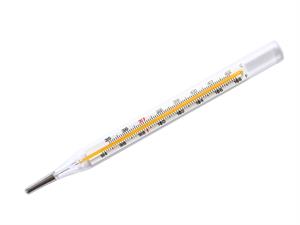
PUMPA - SMART LEARNING
எங்கள் ஆசிரியர்களுடன் 1-ஆன்-1 ஆலோசனை நேரத்தைப் பெறுங்கள். டாப்பர் ஆவதற்கு நாங்கள் பயிற்சி அளிப்போம்
Book Free DemoIn hospitals/clinics, you might have noticed the doctors or nurses using an instrument to measure the temperature of the patients.
What is the instrument?
It is a thermometer - It is the device used to determine temperature.
A Thermometer has two essential elements:
- Temperature sensor - It is used to detect temperature changes.
- Element - It is used to convert the variations in the temperature into a numerical value that is easily understandable.
Clinical Thermometer
The device which is used to measure the temperature of the human body is called a clinical thermometer.
Structure of the clinical thermometer:
- It has a long narrow tube with equal thickness throughout the whole length.
- On one side of this tube, a bulb that comprises mercury. Also, mercury works as a temperature sensor.
- Also, for reading the temperature, there is a scale on the thermometer.
- All clinical thermometers have a very thin capillary tube that starts from the bulb. When there is an increase in temperature, mercury starts to expand through this tube.
- The capillary tube has a bend near the bulb known as kink, which stops the mercury from returning into the bulb when the thermometer is taken out of the patient’s mouth or armpit.

Clinical thermometer
Important!
The normal temperature of our body is 37°C or 98.6°F. However, it can vary between 35°C to 42°C or 94°F to 108°F. Therefore, the clinical thermometer has readings from 35°C to 42°C or 94°F to 108°F.
Temperature scale in clinical thermometer:
There are temperature scales on either side of the mercury thread, one on the Celsius scale and the other on the Fahrenheit scale. Since the Fahrenheit scale is more sensitive than the Celsius scale, body temperature is measured only in °F.
Important!
Precautions to be followed while using a clinical thermometer:
- Handle the thermometer with care.
- You should wash the thermometer before and after use, preferably with an antiseptic solution.
- Jerk the thermometer a few times to bring the level of the mercury down.
- Before use, the mercury level should be below 35°C or 94°F.
- Do not hold the thermometer by its bulb.
- Keep the mercury level along your line of sight, and then take the reading.
- If it hits against some hard object, it may break.
- Do not place the thermometer in a hot flame or under the hot sun.